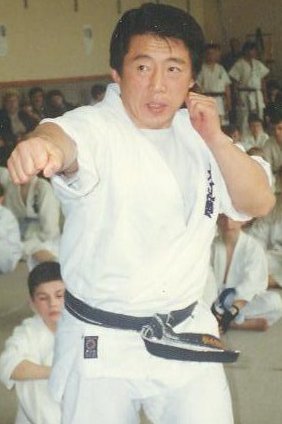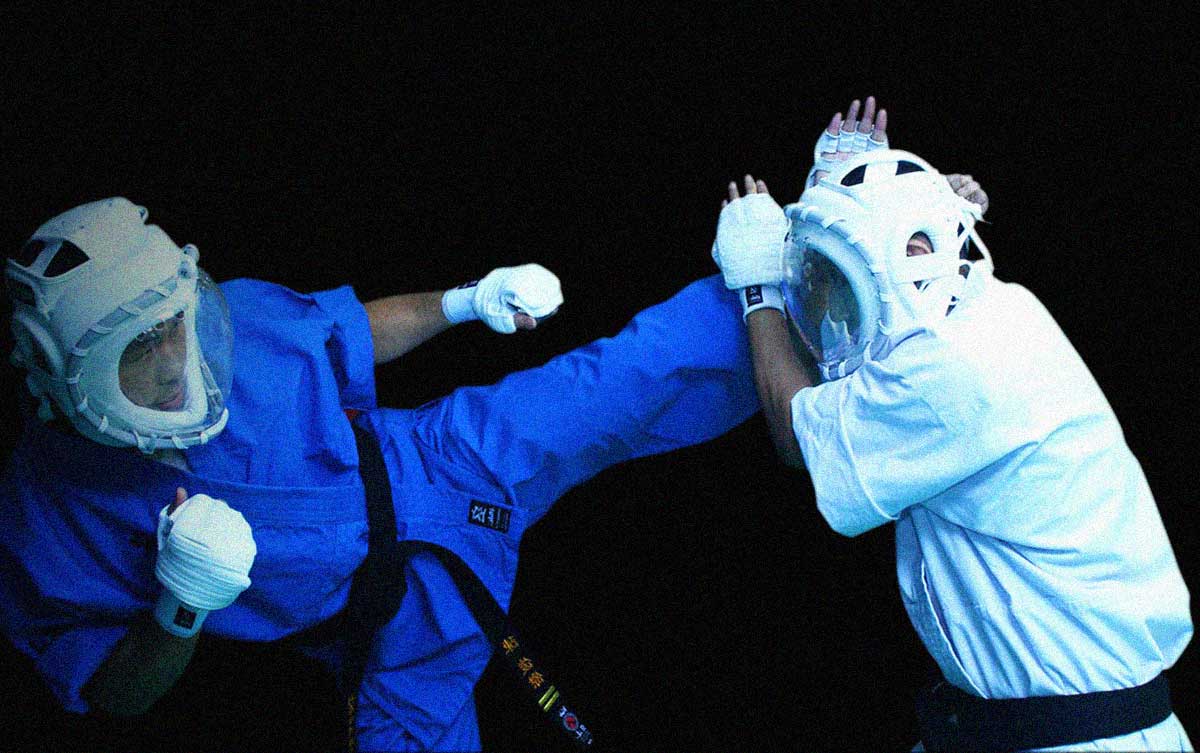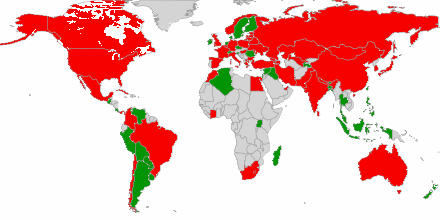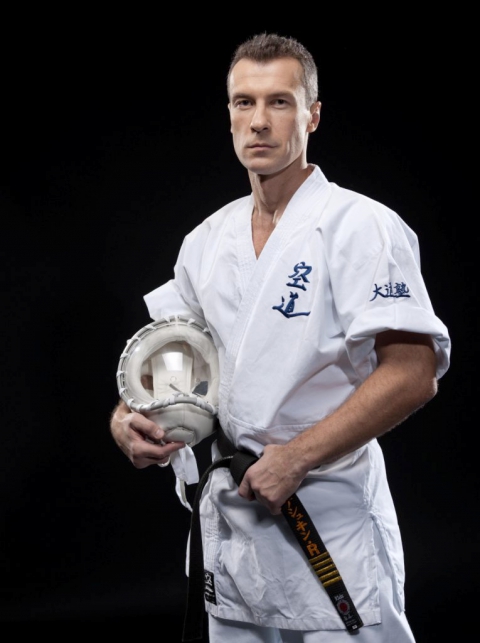1. Overview
Kūdō (空道KūdōJapanese) is a modern Japanese hybrid martial art and full-contact combat sport developed by Takashi Azuma. It combines elements of karate, judo, and jujutsu, aiming for a realistic and versatile fighting style while prioritizing safety through the use of specific protective gear, including headgear and gloves. The sport emphasizes both striking techniques (punches, kicks, elbows, headbutts) and grappling techniques (throws, takedowns, joint locks, chokes, and ground fighting). Kūdō is rooted in the philosophy of Budō, focusing on both physical and mental development to cultivate character and promote positive contributions to society. Established in 1981 by Takashi Azuma as Daido Juku (大道塾Daidō JukuJapanese) and initially known as Kakutō Karate (格闘空手Kakutō KarateJapanese, "Fighting Karate"), the art was officially renamed Kūdō in 2001, signifying its evolution into a distinct budō martial art. Today, Kūdō has expanded globally, with a significant presence in over 50 countries, notably flourishing in Russia.
2. Kūdō: The Martial Art
Kūdō is a comprehensive martial art and philosophy that considers both physical and mental development. Its fundamental principle is to create a realistic and versatile fighting style that incorporates effective offensive and defensive techniques, while ensuring safety through appropriate protective equipment. Unlike some traditional forms, Kūdō training primarily consists of kihon (basic techniques), general fitness training, and combat, with the traditional kata of Kyokushin Karate having been eliminated without replacement. Traditional Japanese etiquette (礼儀reigiJapanese) customary in budō is strictly observed, including specific Japanese greeting rituals and the wearing of a traditional training keikogi, with technique names also being in Japanese.
2.1. Core Concepts and Philosophy
Kūdō's core tenets revolve around realistic combat with a strong emphasis on safety and practicality. The art integrates diverse martial arts techniques, encompassing the full spectrum of real fighting scenarios. This includes stand-up striking with head punches, elbows, and headbutts, combined with throwing techniques, grappling, and ground fighting, which can involve restraint, joint locks, and chokeholds. The integration of various techniques, originally a hybrid of Kyokushin Karate and Judo, later expanded to include elements from boxing, muay thai, jujitsu, and wrestling. This broad approach aims to overcome the limitations of single-style combat, offering a more complete and adaptable fighting system. Protective gear is central to its practicality, allowing for full-contact techniques, particularly hand strikes to the head, while providing sufficient protection.
2.2. Dojo Kun
The Dōjō kun (道場訓Dōjō kunJapanese), or training hall rules, are ethical and philosophical principles that guide Kūdō practitioners. These rules are typically displayed at the entrance or front (正面shōmenJapanese) of a dojo, outlining expected behavior and prohibited actions. The Kūdō Dōjō kun emphasizes character development and positive societal contribution, stating:
Through the pursuit of Kudo,
we develop great physical and mental strength,
educate ourselves and gain intelligence,
and bond with people and enrich our emotions.
Therefore, we shall be able to cultivate our personalities
and become positively contributing members of society.
3. History and Development
The history of Kūdō is deeply intertwined with the vision and efforts of its founder, Takashi Azuma, who sought to create a more comprehensive and safer combat system than existing martial arts.
3.1. Takashi Azuma: Founder's Early Life and Vision

Takashi Azuma (東孝Azuma TakashiJapanese), born on May 22, 1949, in Kesennuma, Miyagi Prefecture, Japan, was the visionary founder of Kūdō and the President of the Kudo International Federation. He held a 9th degree black belt in Kūdō, a 9th degree black belt in Kyokushin Budokai (awarded by Jon Bluming), and a 3rd degree black belt in Kodokan Judo.
3.1.1. Early Life and Martial Arts Beginnings
Azuma's martial arts journey began early in his life. At the age of 16, in 1965, he first encountered budō when he joined the judo club at his high school in Kesennuma, Miyagi Prefecture, where he acquired fundamental judo skills. After graduating, he served in the Japan Ground Self-Defense Force, further shaping his discipline and physical capabilities before embarking on his career in karate.
3.1.2. Career in Kyokushin Karate
In 1971, while still attending Waseda University Second Faculty of Literature, Takashi Azuma formally entered Kyokushin Kaikan and dedicated himself to karate-do. He was instrumental in establishing the Waseda University Kyokushin Karate Club (Waseda Kyokushinkai), serving as its inaugural captain. During his time in Kyokushin, he received instruction from notable figures such as Terutomo Yamazaki and Katsuaki Sato. Azuma gained significant recognition for his participation in championships organized by Kyokushin Kaikan, earning the moniker "Human Locomotive" (人間機関車Ningen KikanshaJapanese) due to his relentless fighting style. His specialty technique was the low kick. He later became the branch chief of the Kyokushin Kaikan Miyagi Prefecture branch, succeeding Kazunori Miyamoto, and organized the Miyagi TV Cup All Tohoku Karate-do Championship, which was the predecessor to the Hokutoki tournament.
Throughout his career in Kyokushin, Azuma achieved notable tournament results:
- In 1973, he made his debut at the 5th All Japan Karate Championship but was defeated in the first round by Toshikazu Sato (karate).
- In 1974, he was the runner-up at the 6th All Japan Karate Championship, where he notably defeated the previous champion, Hatsuo Royama, in the semifinals before losing to Katsuaki Sato in the final.
- In 1975, he placed 6th at the 1st World Open Karate Championship, where he was defeated by Jōkō Ninomiya.
- In 1976, he secured 3rd place at the 8th All Japan Karate Championship, again losing to Jōkō Ninomiya.
- His most significant achievement in Kyokushin was winning the 9th All Japan Karate Championship in 1977, defeating Makoto Nakamura in the semifinals and Takeo Nakayama (karateka) in the final.
- In 1979, he took 3rd place at the 11th All Japan Karate Championship and 4th place at the 2nd World Open Karate Championship, both times losing to Makoto Nakamura in the semifinals.
3.1.3. Motivations for Creating a New Style
Despite his success in Kyokushin, Azuma became increasingly dissatisfied with certain characteristics and rules of the art, which ultimately led him to found his own martial art in 1981. A primary concern for Azuma was the prevalence of serious head injuries in Kyokushin competitions due to its full-contact nature without adequate head protection. He also believed that the rules placed physically smaller fighters at a significant disadvantage against larger opponents, a limitation he experienced firsthand, notably recounting instances where his nose was severely dislocated from blows. Azuma felt that the existing full-contact rules were too restrictive, stating in one of his books that he was "good at grabbing the collar and head-butting in a fight" but felt limited by the Kyokushin rules.
Initially, Azuma expressed pessimism about establishing Daido Juku, stating, "I want to create a karate that can truly beat other competitions, a karate that won't lose in real combat, but currently it's not like that." He critically assessed the effectiveness of karate in real-world combat scenarios by hypothetically comparing ten representatives from various martial arts. He controversially claimed that Sumo would be the strongest, followed by Wrestling (specifically the 130 kg and over class, a category later abolished in international competitions), and then Boxing's heavyweight division, openly questioning where karate would rank in such a comparison. This critical stance was perceived as a challenge to his master, Mas Oyama. Manga artist Keisuke Itagaki later commented on Azuma's assessment, explaining that Azuma's ranking of sumo as number one highlighted "sumo's incredible power."
3.2. Establishment of Daido Juku and Kakutō Karate
The Daido Juku organization officially began operations on February 17, 1981. The first dojo, named "Karate-do Daidojuku," was opened in Miyagi Prefecture. The martial arts style developed within the organization was initially known as Kakutō Karate (格闘空手Kakutō KarateJapanese, "Fighting Karate") or Combat Karate Daidojuku. In the same year, Daidojuku's practitioners made their competitive debut at the "1981 Hokutoki Karate Championships."
A fundamental principle behind Daido Juku was the creation of a realistic and versatile fighting style that incorporated effective offensive and defensive techniques across various ranges. This early development was a hybrid of Kyokushin Karate and Judo, using Kyokushin as a base but with dramatically altered regulations. The style aimed to transcend the boundaries of a single discipline, integrating techniques such as head punches, elbows, headbutts, throws, and joint locks from Judo, along with other ground fighting techniques. Throughout the 1980s and 1990s, the style expanded to include techniques from boxing, muay thai, jujitsu, and wrestling, all integrated under the Daidojuku framework. Crucially, protective clothing was introduced, which allowed hand techniques to the head while providing sufficient protection during kicking techniques.
Daido Juku played a significant role in the martial arts boom in Japan during the late 1980s and early 1990s, standing out as one of the few organizations promoting mixed martial arts at the time. It is credited with helping popularize major promotions like K-1 and the "U-series" promotions within the Japanese mainstream. Notably, Minoki Ichihara, a Kakuto Karate practitioner from Daidojuku, became the first Japanese fighter to compete in the UFC, fighting at UFC 2 when many Japanese martial arts organizations were hesitant to engage with the nascent UFC. However, Ichihara was defeated by Royce Gracie.
In the 1990s, Daido Juku hosted its own kickboxing events called THE WARS, which featured a "gloved" ruleset for full-contact karate and showcased the organization's top talents. During this period, there was considerable media anticipation for a "dream confrontation" between Kenichi Osada, Daido Juku's ace fighter, and Masaaki Satake of Seidokaikan. Daido Juku athletes frequently appeared on the covers of various martial arts magazines, solidifying Daidojuku's position alongside Seidokaikan as a leading force in Japanese martial arts. In 1995, the association officially changed its name from "Karate Do Daidojuku" to the "Kakuto Karate International Federation Daidojuku" (KKIF).
3.3. Evolution to Kūdō and International Recognition
From the mid-1990s onward, Daido Juku shifted its focus away from media-centric promotion and returned to its foundational goal of developing a "safe yet practical" fighting style. This culminated in 2001, when Takashi Azuma, the founder and president of Daidojuku, held an official press conference to announce that the style promoted by Daidojuku would henceforth be known as Kūdō. This marked its official recognition as a distinct budō martial art. The relationship between the Daido Juku school and Kūdō mirrors that between the Kodokan Judo Institute and Judo, signifying Kūdō's formalized status within the martial arts world. In the same year, Daidojuku successfully launched the first Kūdō World Championship competition, propelling the art onto the international stage.
Based on the philosophy of budō, Kūdō has expanded globally. All Kūdō instructors and leaders worldwide are certified and registered under the Kudo International Federation (K.I.F.), the governing body for the sport. The K.I.F. distinguishes itself by operating as a social and physical education organization, receiving support from governmental bodies like the Japanese Ministry of Education, Culture, Sports, Science and Technology for its activities.
4. Technical Aspects and Competition Rules
Kūdō is characterized by its unique equipment, innovative combat categories, and specific regulations designed to promote safety and realistic combat.
4.1. Equipment

Kūdō athletes, known as kudoka, wear an official uniform called a "dogi" or "kudogi." This uniform is similar to a judo gi in its resistance to throwing techniques but features shorter sleeves than a traditional karate gi, making it ideal for gripping and throwing maneuvers. Kūdō practitioners commonly wear white and blue dogi for easy identification during competition.
For safety during training and competition, all athletes are required to wear specific protective gear:
- A dogi (uniform).
- Headgear, which includes a special K.I.F.-approved Plexiglas visor designed to protect fighters from severe facial damage and brain trauma.
- A kudo bandage.
- A mouthguard.
- K.I.F.-approved gloves that protect the knuckles but leave the fingers free and uncovered to allow for grappling techniques.
For underage athletes, additional protective gear is mandatory:
- In addition to the dogi, Plexiglas helmet, and gloves, minors must wear shin guards and a bodice.
- Regulations regarding the protection of underage athletes may vary slightly between different tournaments.
4.2. Combat Categories
Kūdō employs a distinctive system for categorizing athletes, based not solely on weight but on a "physical index" (PI). The physical index is calculated as the sum of an athlete's weight in kilograms plus their height in centimeters. This unique categorization system aims to promote fair competition by considering an athlete's overall physicality, as height can provide an advantage in terms of reach over long distances.
The combat categories based on the physical index are:
| Physical Index (PI) Category |
|---|
| under 91 in (230 cm) |
| 91 in (230 cm)-94 in (240 cm) |
| 94 in (240 cm)-98 in (250 cm) |
| 98 in (250 cm)-102 in (260 cm) |
| 102 in (260 cm)-106 in (270 cm) |
| 106 in (270 cm) and over |
4.3. Regulations
Kūdō competitions adhere to a set of definitive base rules, with individual tournaments often incorporating their own specific rules that remain rooted in these core regulations. The regulations used at Kūdō World Championships include the following:
- Ground fighting is limited to two instances per match, each lasting no more than thirty seconds.
- Blows to the back and private parts are strictly prohibited.
- Competitions are held on a tatami mat measuring 43 ft (13 m) by 43 ft (13 m), with an internal fighting area demarcated by a 30 ft (9 m) by 30 ft (9 m) square.
- During a match, there are four referees positioned at the corners of the contest area, in addition to one referee inside the tatami.
Points are awarded based on the strength and effectiveness of techniques, rather than mere execution. The scoring system emphasizes how much the opponent felt the impact of a blow, reflecting the practicality of the strike. The point values range from 1 to 8, with specific terms for each level:
- Koka (有効KōkaJapanese): 1 point
- Yuko (有効YūkōJapanese): 2 points
- Wazari (技ありWaza-ariJapanese): 4 points
- Ippon (一本IpponJapanese): 8 points (an immediate victory)
Victory in a Kūdō match can be achieved through several methods:
- Scoring 8 points (Ippon).
- Submission or choke-out.
- A knockout.
- By decision based on which fighter has accumulated more points by the end of the match.
In the event of a tie, the outcome is determined either by a referee's decision or by engaging in another match.
5. Global Presence and Inter-organizational Relations
Kūdō has expanded significantly beyond Japan, establishing a substantial international footprint and engaging in various exchanges with other martial arts organizations.
5.1. International Spread and Growth

Kūdō maintains over 100 dojo locations in Japan and is practiced in more than 50 countries worldwide. Notably, despite being a Japanese-created martial art, Russia currently boasts the largest number of Kūdō athletes, surpassing the number of practitioners in Japan.
The development of Kūdō in Russia has been particularly robust:
- In 1991, the first Daido Juku karate-do section in Russia was opened in Vladivostok.
- Following a visit by founder Takashi Azuma to Moscow, a foreign branch of the Kudo Federation was established there.
- On July 7, 1994, the Moscow Federation of Daido Juku Karate-do was officially registered by the Moscow Justice Department.
- In May 1994, Moscow hosted the Moscow Cup, which marked the first international Daido Juku tournament held in Russia.
- Russian athletes achieved their first victory in Japan in 1996, when Alexey Kononenko secured first place in his weight category.
- The Russian Kudo Federation was officially established in 2004.
- Since 2001, the official Russian Championship in Kūdō has been held annually. In the inaugural year, Russian athletes earned two gold, three silver, and two bronze medals.
- In 2003, Russian Kūdō practitioners led the refereeing team at the 2nd international tournament "Baltic States Open Cup," which featured athletes from Russia, Japan, the Baltic countries, Azerbaijan, Italy, Germany, and Poland.
- The 1st Kudo World Cup was hosted in Moscow in 2011.
- On January 13, 2013, Roman Anashkin achieved the rank of 6th dan in Kūdō, becoming the first non-Japanese practitioner to attain such a high degree.
5.2. Exchange with Other Martial Arts Organizations
During the 1990s, prior to the official conception of Kūdō, Daido Juku actively engaged in talent exchanges with numerous other martial arts organizations, a practice that ceased after Kūdō became a distinct style. In this period, Daidojuku had formal agreements with Submission Arts Wrestling (SAW) and subsequently interacted with entities involved in Wushu, Sanshou, Aikido, Paraestra, and Hatenkai. Furthermore, selected fighters from Daidojuku participated in competitions organized by other martial arts promotions, such as RISE. Historically, Daidojuku also engaged in competitive exchanges with organizations like Nippon Kempo and Shooto. The organization has also seen clashes with practitioners of Muay Thai, Sanshou, and Taekwondo.
5.3. Takashi Azuma's Official Roles and Contributions
Takashi Azuma held significant public appointments and made notable contributions to the broader martial arts world. He served as the Director of both the Kudo International Federation and the All Japan Kudo Federation. A prominent role was his appointment as the head coach for the Sanda Japanese national team at the 2008 Beijing Wushu Tournament, which was held concurrently with the 2008 Summer Olympics and approved by the International Olympic Committee (IOC). During this tournament, Kazunari Sasazawa of Daido Juku competed, and both Azuma and Sasazawa were affiliated with the Tokyo Wushu Sanshou Club for the event.
6. Notable Practitioners

Several individuals have achieved recognition in Kūdō or significantly contributed to its visibility:
- Semmy Schilt: A renowned mixed martial artist and kickboxer, he was the Hokutoki champion in both 1996 and 1997.
- Roman Anashkin: A prestigious Russian martial artist who holds a 7th dan black belt in Kūdō. He was the first non-Japanese to achieve a 6th dan.
- Yoshinori Nishi: A mixed martial arts fighter and founder of the Wajyutsu Keishukai gym, he was the Hokutoki champion in 1984 and 1985.
- Lee Hasdell: A mixed martial artist and kickboxer.
- Katsumasa Kuroki: A professional wrestler better known by his ring name Magnum Tokyo.
- Minoki Ichihara: A mixed martial artist and a competitor in UFC 2, he was the first Japanese fighter to participate in the UFC.
- Disha Patani: An Indian actress and fitness enthusiast.
- Kolyan Edgar: An Honored Master of Sports of Russia in Kūdō, he is a two-time Kūdō world champion (2005, 2009), a silver medalist at the 2014 World Kūdō Championship, a bronze medalist at the 2018 World Kūdō Championship, winner of the 2011 Kūdō World Cup, the 2008 European Kūdō champion, and a five-time Russian Kūdō champion. He also holds titles as a Candidate for Master of Sports of Russia in Army hand-to-hand fighting and Combat Sambo.
- Hisaki Kato: A mixed martial artist who competes in Bellator MMA and Kickboxing.
- Akshay Kumar: A prominent Bollywood superstar and martial artist.
- Taapsee Pannu: A Bollywood actress and martial artist.
- Mehul Vora: Holds a 5th Dan Black Belt in Kūdō and is recognized for his contributions to Indian martial arts.
- Vladimir Zorin (Kudo): Coach of the Russian national Kūdō team, an international category judge in Eastern martial arts, and Vice-President of the Russian Kudo Federation. He holds a 6th dan black belt in Kūdō and authored the book "Fundamentals of Kudo." Alongside Roman Anashkin, he is considered one of the progenitors of Kūdō in Russia.
- Irina Bykova (Kudo): The 2005 World Kūdō Champion in the women's absolute weight category, she is an 18-time Russian Kūdō champion, the 2008 European Kūdō champion, and holds a 4th Dan in Kūdō.
7. Writings and Media Appearances
Takashi Azuma documented his martial arts philosophy and the techniques of Kūdō in several published works and also made appearances in films.
7.1. Published Works
Takashi Azuma authored several books that delve into his theories on martial arts and the development of Kūdō:
- Hamidashi Karate (はみだし空手Hamidashi KarateJapanese) (1982, Fukushodo): This work explores his early concepts related to breaking away from traditional karate limitations.
- Kakuto Karate (格闘空手Kakutō KarateJapanese) (1983, Fukushodo)
- Kakuto Karate 2 (格闘空手2Kakutō Karate TsūJapanese) (1986, Fukushodo)
- Oi Masaaki! (オーイ まさぁーき!Ōi Masaaki!Japanese) (2001, Bungeisha)
- Hamidashi Karate Kara Kudo e (はみだし空手から空道へHamidashi Karate Kara Kūdō eJapanese, "From Hamidashi Karate to Kūdō") (2002, Fukushodo)
- Kudo Nyumon (空道入門Kūdō NyūmonJapanese, "Introduction to Kūdō") (Baseball Magazine Sha)
7.2. Film Appearances
Takashi Azuma also made appearances in martial arts-related films, providing a public face for his influence beyond the dojo:
- Karate Brawlers: Kyokushin Fist (けんか空手 極真拳Kenka Karate KyokushinkenJapanese) (1975, Toei): In this film, he appeared as an opponent of Mas Oyama (portrayed by Sonny Chiba) in the All Japan Karate-do Championship semifinals.
- Ground Strongest Karate series (地上最強のカラテシリーズChijō Saikyō no Karate ShirīzuJapanese): He appeared as himself in this series, including:
- Strongest and Last Karate (最強最後のカラテSaikyō Saigo no KarateJapanese) (1980, Sankyo Eiga).
8. Personal Life and Other Affiliations
Beyond his contributions to Kūdō, Takashi Azuma was involved in community endeavors. He held the honorary title of Minato Kesennuma Ambassador (みなと気仙沼大使Minato Kesennuma TaishiJapanese), reflecting his connection to his hometown.
9. Death and Legacy
Takashi Azuma's passing marked a significant moment for the Kūdō community, but his enduring vision continues to shape the martial art.
9.1. Death
Takashi Azuma died on April 3, 2021, at 2:35 PM (JST) due to stomach cancer, at the age of 71. Following his death, the position of President of Daido Juku was officially transferred to Kenichi Osada.
9.2. Historical Assessment and Succession
Takashi Azuma is historically assessed as a pioneering figure in the world of martial arts, particularly for his innovative creation of Kūdō. His vision to move beyond the limitations of traditional full-contact karate, especially concerning head injuries and disadvantages for smaller fighters, led to the development of a hybrid combat sport that emphasized both safety through protective gear and practical, versatile techniques. Kūdō, under his leadership, transformed from an experimental fighting style into a globally recognized budō martial art. His contributions paved the way for a more inclusive and comprehensive approach to martial arts competition. The continuation of Daido Juku and the Kudo International Federation under the leadership of Kenichi Osada after Azuma's passing ensures the ongoing legacy and development of the art he founded.